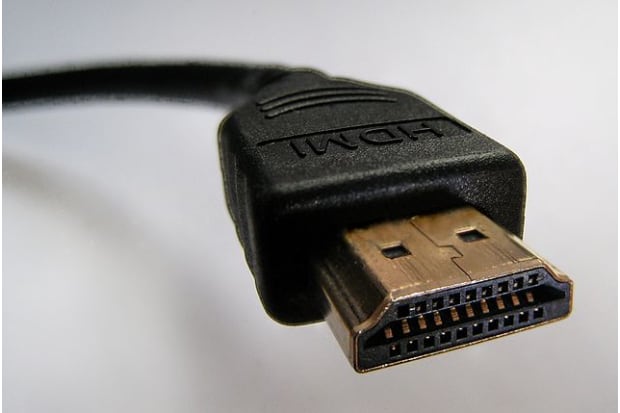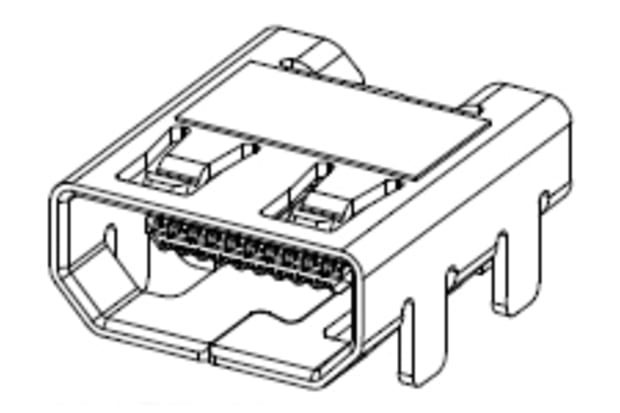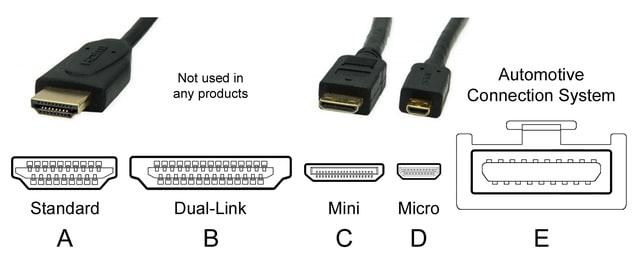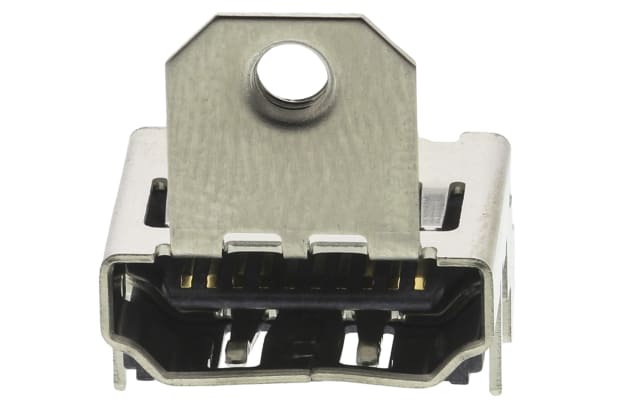- Published 11 Mar 2024
- Last Modified 11 Mar 2024
- 12 min
Everything You Need to Know About HDMI Connectors
Unravel the intricate world of HDMI connectors. Explore their purpose, types, sizes, specifications, and more in our guide.

In this guide, we’ll explore the different types of HDMI connectors. We'll also discuss which types are best suited to various applications, and cover connector specifications, genders, and some handy FAQs.
What is an HDMI Connector?
An HDMI connector is a vital I/O hardware component in communication or entertainment equipment. It enables HDMI cables to transfer uncompressed digital A/V signals from suitable sources to connected display devices or receivers.
HDMI connectors are commonly used to link projectors to game consoles, TVs to set-top boxes, monitors to desktop computers, and much more besides. In fact, across all workplace communications technologies, HDMI has become a highly popular and widely used format for carrying high-quality audio-visual signals between source and display.

HDMI stands for High Definition Multimedia Interface. This high-end modern format was initially developed in the early 2000s, aiming to improve the overall convenience and functionality of existing standards for carrying HDTV signals.
Before HDMI, they were limited to component video, DVI, or SCART. Originally designed for computer monitors, DVI is a video-only connector. Component video, although effective at transferring HD signals once hooked up, required users to route multiple cables if they wanted both audio and video to transfer at the same time.
HDMI was designed to combine these separate cables into one. It was designed to replace SCART, VGA and SVGA, the same as DisplayPort. After intense testing and research worldwide, HDMI was launched as a range of commercially available connectors and cables in 2002.
HDMI component sales increased exponentially over the following 3-5 years. Today, it has become the go-to choice for home and workplace audio-visual signal transfer. As with the developers’ original vision, a single sturdy HDMI cable is capable of carrying ultra-high-quality audio-visual signals reliably and neatly between wired devices.
HDMI connectors themselves function like any other familiar cable-based plug-and-socket system. Indeed, USB and HDMI look similar, although HDMI is typically larger.
As with many audio-video cable components, male and female HDMI connectors are available depending on which side of the interface they must support to complete the connection. Like most plugs and sockets, male HDMI connectors feature a protruding pin area and are smaller. In contrast, female connectors are larger and recessed.
In addition to these basic male/female characteristics, there are also different HDMI connector types, sizes and layouts available.
HDMI Connector Specifications
HDMI connectors are notable among other types of wired connectors and terminals for the quality, bandwidth, and speed of A/V signals they carry. Since the first HDMI products were launched in 2002, there have been several revisions and official iterations of the HDMI standard. Each revision delivered its own updated HDMI connector specifications.
To date, the key HDMI revisions are:
HDMI Version | Year Released |
|---|---|
HDMI 1.0 | 2002 |
HDMI 1.1 | 2004 |
HDMI 1.2 and 1.2a | 2005 |
HDMI 1.3 | 2006 |
HDMI 1.4 | 2009 |
HDMI 1.4a | 2010 |
HDMI 1.4b | 2011 |
HDMI 2.0 (also known as HDMI UHD) | 2013 |
HDMI 2.0a | 2015 |
HDMI 2.0b | 2016 |
HDMI 2.1 | 2017 |
Each of these revisions delivered successive expansions in overall functionality and performance, and so the universal HDMI connector specs have constantly evolved over the format's lifetime.
Version 1.2 (2005), for example, broadened the range of resolutions and refresh rates supported by HDMI, in a successful attempt to popularise the format among computer owners. Version 1.4 (2009-2011) added support for 4K signals and shared Ethernet connectivity between devices, while version 2.0 (2013-2016) dramatically improved both video bandwidth and audio sample frequency, allowing for simultaneous streaming of HDR visuals and dynamic audio-video synchronisation.
What Does an HDMI Connector Look Like?

HDMI connectors look similar to USB connectors. In each case, the male sides of the connector usually protrude from the cable ends. They are typically intended for insertion into female connectors, sockets, or hubs that are recessed into the devices being linked.
There are, however, some notable physical differences between USB and HDMI. There are a few distinct differences between full-size HDMI connectors and standard USB connectors, including their trapezium shape and unequal lengths on the opposing sides of the connector.
The HDMI connector diagram to the right shows the classic outline that many will recognise immediately from the I/O panels of their own TVs, games consoles, and computer monitors.
While there are various sizes and configurations of HDMI cables and connectors available, the ones in widespread day-to-day use all share the same basic shape and layout.
Types of HDMI Connectors
Many different HDMI connectors are available today. Even though they do the same thing, they aren't always interchangeable between devices or applications. In other words, you’ll need to know which connector type you're using before buying.
The different types are shown in the HDMI connector pinout and visual representation below:

Currently, five standard HDMI cable connector types are available, namely:
- Type A (standard)
- Type B (dual-link - not currently used in mainstream consumer products)
- Type C (mini)
- Type D (micro)
- Type E (Automotive Connection System, designed primarily for use in vehicles)
Different HDMI cable connector types have noticeably different sizes, making them easy to identify. However, if you’re not familiar with the naming schemes for HDMI types, the range of available options can look confusing at first glance. Rest assured that for the vast majority of applications, only HDMI connector types A, C, and D (standard, mini, and micro) will be needed.
HDMI Type A Connector
The type A HDMI connector is the archetypal standard version of HDMI that most users would immediately recognise, as well as the most widely used and readily available of the five HDMI connector sizes. They’re by far the most familiar HDMI connector types and are found on almost every brand of modern TV, monitor, game console, and desktop computer.
HDMI type A male connectors measure 13.9mm x 4.45mm. At 14mm x 4.55mm, female sockets are slightly larger. Like both the mini and micro versions of HDMI (types C and D respectively), type A is a 19-pin connector designed to carry audio-video signals ranging in bandwidth from standard definition (SDTV) through to 4K UHD.
HDMI Type C Mini Connector
Type C mini HDMI connectors are a smaller, slimmed-down version of type A, and are very commonly found on various types of portable equipment. Typical examples might include DSLR cameras, camcorders, large tablets, and sat nav systems. The size of the type C mini HDMI plugs is 10.42mm x 2.42mm.
Just like its even smaller cousin the micro HDMI connector, mini HDMI connectors share the full functionality of standard type A versions in a more compact package. Like the micro version, HDMI mini cables are most often sold with a mini type C plug at one end, and a standard type A plug at the other. However, products with mini or micro connectors at each end are also available if needed.
HDMI Type D Micro Connector
Type D HDMI connectors are micro versions. These are smaller than standard and mini HDMI connectors. However, they retain the same 19-pin configuration, albeit in a slightly different layout due to microformat size constraints.
Type D micro HDMI connector specification includes measurements of just 5.83mm × 2.20mm, which makes them similar in overall size to a micro-USB connector. They are less than half the size of a standard HDMI type A plug or socket. Type D was developed specifically for audio-video connectivity in very small, highly portable devices such as mobile phones.
Female and Male HDMI Connectors
HDMI female connectors are usually built into both the signal source and the receiving device as sockets for a male-end cable. In the most common arrangement, a cable with two male ends is plugged into two female sockets simultaneously. This provides direct wired connectivity between the source and display devices.
As female HDMI connectors are usually recessed into the body of TVs, games consoles, projectors, computers, and monitors - and because they tend to be more susceptible to deforming under excessive strain than male connectors - they’re more widely sold as standalone replacement parts.
Male HDMI connectors, on the other hand, are generally supplied as fixed components at either end of almost every commercially available HDMI cable. In many situations, it’s easier and cheaper to replace a damaged male connector by swapping in a replacement cable. However, this isn’t always practical. Some high-end HDMI cables can be relatively expensive (especially the longer and sturdier types), and so in these cases, it can be considerably cheaper to wire a new male connector than to replace an entire cable run.
In addition, many people choose to route HDMI cables behind walls or between floors of a building. It can be a complicated process to remove and re-lay these if one of the male connectors gets damaged. For this reason, most reliable suppliers that stock female HDMI sockets also offer equivalent male components.

Straight and Right-Angle HDMI Connectors
When plugged in, a standard straight connector for HDMI extends horizontally out of the female socket, similar to a standard USB cable or 3.5mm jack plug. This is the most common type of HDMI connector and is generally suitable for most setups.
However, in scenarios where the amount of space immediately in front of an HDMI socket is limited, it’s also possible to purchase right-angled HDMI connectors. These are designed to point immediately downward upon exiting the socket. This helps the connector and the cable sit flush against the device.
HDMI right-angle connectors can be especially useful if a TV or computer is placed with its I/O ports very close to a wall, for example, or if the relative positions of source and receiver devices would strain a straight HDMI connection. It can also be handy for improving general cable management around the back of many device types, keeping things neat and easy to access.
What is an HDMI Connector Used for?

In the majority of standard use scenarios, HDMI cables and connectors of all types will be used to transfer simultaneous audio and video signals from a source to a receiver or display. After all, that’s what they were originally designed to do, without users having to link up multiple different sets of cables (or the much more unwieldy DVI connectors) to get both types of signal carried at once.
However, HDMI can also be used purely for audio or video signals due to its broad backward compatibility with older connection standards. This is particularly useful because, with the addition of the right adaptor, HDMI cables and connectors can link hardware devices with a number of different port types.
Audio and Video Use
The original purpose of HDMI was to update and replace the existing DVI connector standard still present on computer monitors and other video display hardware. DVI is a video-only output, and although audio and video signals can be carried simultaneously over HDMI, it’s also compatible with DVI electrically.
HDMI-DVI connectors allow users to connect HDMI cables to more modern screens or receivers without DVI ports. This enables the resulting image to be displayed perfectly. Similarly, by using the right adaptor, HDMI audio connectors can also be used to transmit only sound signals from devices with older-style component audio ports.
FAQs
Summary
Today’s HDMI connectors provide a wealth of options for transferring very high quality, high bandwidth audio-video signals between a wide range of modern entertainment and communications equipment. And, thanks to their engineered backward compatibility with earlier audio-video transfer formats, they can also provide an effective link-up between devices without identical HDMI ports if the right adaptor is chosen.
Please feel free to contact a member of our expert support team if you’d like further information or advice about HDMI cables and connectors. You can also ask about setting up your equipment using this popular connection standard for the most reliable results and device performance.